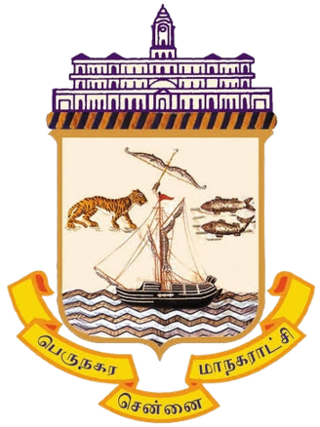
Greater Chennai Corporation (GCC) is a local government for the City of Chennai in the Chennai Metropolitan Area of Tamil Nadu, India. Inaugurated on 29 September 1688, under a royal charter issued by King James II of England on 30 December 1687 as the Corporation of Madras, it is the oldest municipal body of the Commonwealth of Nations outside Great Britain. It is the largest municipal corporation in Tamil Nadu with an area of 426 km2. It is headed by a mayor, who presides over 200 councillors, each of whom represents one of the 200 wards of the city. It is the second oldest corporation in the world after the City of London. The city limits, which had been expanded several times over the years, is currently coterminous with the Chennai district. It is one of the four municipal corporations located within the Chennai Metropolitan Area, the other three being the Tambaram Corporation, Avadi City Municipal Corporation and Kanchipuram Municipal Corporation.

Chennai Mofussil Bus Terminus, officially Puratchi Thalaivar Dr. M.G.R. Bus Terminus, is a bus terminus located in Chennai, India, providing inter-state bus transport services. It is located on the Inner Ring Road in Koyambedu and is one of the largest bus terminus by area in India.

The Government Botanical Garden is a botanical garden in Udhagamandalam, near Coimbatore (Ooty), Tamil Nadu state, India laid out in 1848. The gardens, divided into several sections, cover an area of around 22 hectares, and lie on the lower slopes of Doddabetta peak. The garden has a terraced layout. It is maintained by the Tamil Nadu Horticulture Department.
Madhavaram is a neighbourhood of Chennai, Tamil Nadu, India. Located in the northern part of Chennai, it is also a taluk in Chennai District and a zone in Greater Chennai Corporation. It is located in between Perambur and Kodungaiyur. As of 2011, the neighbourhood had a population of 119,105. The Chennai district was expanded on 16 August 2018 by transferring Madhavaram taluk from Tiruvallur district to Chennai district.

Tholkappia Poonga or Adyar Eco Park is an ecological park set up by the Government of Tamil Nadu in the Adyar estuary area of Chennai, India. According to the government, the project, conceived based on the master plan for the restoration of the vegetation of the freshwater ecosystems of the Coromandel Coast, especially the fragile ecosystem of the Adyar estuary and creek, was expected to cost around ₹ 1,000 million which will include the beautification of 358 acres of land. The park's ecosystem consists of tropical dense evergreen forest, predominantly comprising trees and shrubs that have thick dark green foliage throughout the year, with over 160 woody species, and comprises six vegetative elements such as trees, shrubs, lianas, epiphytes, herbs and tuberous species. The park was opened to public by Chief Minister M. Karunanidhi on 22 January 2011 and named after the renowned Tamil scholar Tholkappiar. About 65 percent of the park is covered by water and artefacts and signages. In the first 2 months of its inauguration, nearly 4,000 children from several schools in the city and the nearby Kancheepuram and Tiruvallur districts have visited the park to learn about wetland conservation, eco-restoration and water management. While the first phase of the ecopark covered about 4.16 acres of CRZ-III area, the entire area covered under the second phase falls under this category.
Pattabiram is a neighbourhood situated on the western part of Chennai, India. The suburb, which falls under Avadi Municipal Corporation, is about 25 km from the Chennai Central railway station. It is an immediate neighbour of Chennai city proper, and a part of the Chennai Metropolitan Region. It is situated in the western portion of the city.
Madhavaram Milk Colony is a neighbourhood in northern Chennai, a metropolitan city in Chennai district in the Indian state of Tamil Nadu.

Salem Airport is a domestic airport serving the city of Salem, along with neighboring cities of Erode and Karur, in Tamil Nadu, India. It is located at Kamalapuram in Omalur taluk, 19 km (12 mi) north-west from the city centre. It was the sixth-busiest airport in Tamil Nadu after Chennai, Coimbatore, Tiruchirappalli, Madurai, and Tuticorin airports. It is also the fifth-largest airport in Tamil Nadu in terms of runway length.
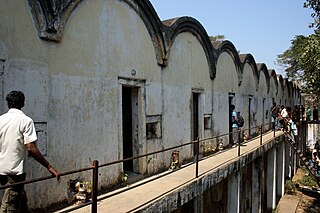
Madras Central Prison was one of the oldest prisons in India. It was located in Chennai in the Indian state of Tamil Nadu. It became operational during the British Raj period. Its prisoners were moved to the newly constructed Puzhal Central Prison starting in 2006, with the 172 year old prison being demolished in June 2009.
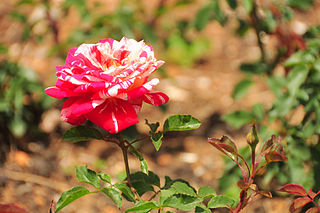
The Government Rose Garden is situated on the slopes of the Elk Hill in Vijayanagaram of Ooty town in Tamil Nadu, India at an altitude of 2200 meters.

Semmozhi Poonga, variously spelled as Semmoli Poonga, is a botanical garden in Chennai set up jointly by the Horticulture and Agricultural Engineering department of the Government of Tamil Nadu. The garden was opened on 24 November 2010 by then chief Minister M. Karunanidhi and is the first botanical garden in the city. The garden is located in the Cathedral Road–Anna Salai junction, opposite the American Consulate, on the erstwhile Drive-in Woodlands Hotel. Encompassing an area of 20 acres, it was built at a cost of ₹ 80 million. More than 500 species of plants are being grown in the area, in addition to the 80 trees that were already in existence during the development of the park, some of them being more than 100 years old. The garden houses some of the popular exotic flora and rare plant species, medicinal and aromatic herbs. Many of the exotic plants are imported from countries like China and Thailand, including a plethora of bonsai varieties of ficus microcarpa and ficus ginseng.
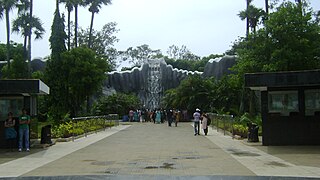
Arignar Anna Zoological Park, also known as the Vandalur Zoo, is a zoological garden located in Vandalur, Chennai, India, about 31 kilometres (19 mi) from the Chennai Central and 15 kilometres (9.3 mi) from Chennai Airport. Established in 1855, it is the second public zoo in India. It is affiliated with the Central Zoo Authority of India. Spread over an area of 602 hectares, including a 92.45-hectare (228.4-acre) rescue and rehabilitation centre. The zoo houses 2,553 species of flora and fauna across 1,265 acres (512 ha). As of 2012 the park houses around 1,500 wild species, including 46 endangered species, in its 160 enclosures. As of 2010, there were about 47 species of mammals, 63 species of birds, 31 species of reptiles, 5 species of amphibians, 28 species of fishes, and 10 species of insects in the park. The park, with an objective to be a repository of the state's fauna, is credited with being the second wildlife sanctuary in Tamil Nadu after Mudumalai National Park.
Mathur is a residential area located north of Chennai, a metropolitan city in Tamil Nadu, India. Mathur is administered by the Greater Chennai Corporation and belongs to Madhavaram taluk of Chennai district.

Pallikaranai Marsh is a freshwater marsh in the city of Chennai, India. It is situated adjacent to the Bay of Bengal, about 20 kilometres (12 mi) south of the city centre, and has a geographical area of 80 square kilometres (31 sq mi). Pallikaranai marshland is the only surviving wetland ecosystem of the city and is among the few and last remaining natural wetlands of South India. It is one of the 94 identified wetlands under National Wetland Conservation and Management Programme (NWCMP) operationalised by the Government of India in 1985–86 and one of the three in the state of Tamil Nadu, the other two being Point Calimere and Kazhuveli. It is also one of the prioritised wetlands of Tamil Nadu. The topography of the marsh is such that it always retains some storage, thus forming an aquatic ecosystem. A project on 'Inland Wetlands of India' commissioned by the Ministry of Environment and Forests, Government of India had prioritised Pallikaranai marsh as one of the most significant wetlands of the country. The marsh contains several rare or endangered and threatened species and acts as a forage and breeding ground for thousands of migratory birds from various places within and outside the country. The number of bird species sighted in the wetland is significantly higher than the number at Vedanthangal Bird Sanctuary.

Chetpet Lake is a lake spread over 16 acres in Chetpet, Chennai, India. It is located to the north of Chetpet railway station. It is the only existing lake at the centre of the city. The lake belongs to the Department of Fisheries of the Tamil Nadu government.

Koyambedu Wholesale Market Complex (KWMC) is one of Asia's largest perishable goods market complex located at Koyambedu, Chennai. The market complex is spread over an area of 295 acres (1.19 km2). Inaugurated in 1996, the complex consists of about 3,100 shops, including more than 1,000 wholesale shops and 2,000 retail shops. Of these, 850 are fruit shops. It abuts the Poonamallee High Road and Nesapakkam Road and can be easily accessed from all parts of City. In Phase I, a wholesale market for perishables was developed in an area of around 70 acres (280,000 m2) by constructing 3,194 shops. The market has two blocks for vegetable shops and one each for fruit and flower shops. In Phase II, a textile market and in Phase III, a food grain market have been planned to be developed in the complex.
Mathur MMDA Park, is an urban park in the neighbourhood of Mathur MMDA, Chennai.
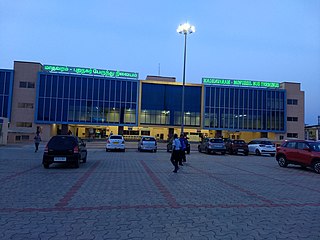
Madhavaram Mofussil Bus Terminus is a bus terminus in Chennai, India, located in the neighbourhood of Madhavaram, providing outstation/inter-state transport services. Spread over an area of 8 acres (32,000 m2), it was built to decongest the Chennai Mofussil Bus Terminus in Koyambedu. It will chiefly handle buses to Andhra Pradesh and Telangana, including cities such as Chittoor, Tirupati, Nellore, Vijayawada, Kurnool, Puttaparthi, Visakhapatnam, Bhadrachalam, and Hyderabad. As of 2018, the number of passengers travelling from Chennai to these two states daily average 12,500. The Tamil Nadu and Andhra governments operate about 315 services daily, with the number increasing during weekends.

Kilambakkam Bus Terminus, officially Kalaignar Centenary Bus Terminus, is a bus terminus in Kilambakkam, a southern suburb of Chennai, India. Situated along the GST Road, it became operational on 30 December 2023. Spread over an area of 88.52 acres (358,200 m2), it was built to decongest the Chennai Mofussil Bus Terminus in Koyambedu. It is an integrated bus terminus for mofussil buses operated by TNSTC, SETC, KSRTC, KSRTC SWIFT and contract carriage buses. The terminus is connected to other parts of the Chennai Metropolitan Area and suburbs by MTC buses.
Perungavoor, is a suburb located North of Chennai, a metropolitan city in Tamil Nadu, India.














